“Les Amants” by René Magritte – The Lovers Painting Analysis
René Magritte, one of the most renowned Belgian surrealist painters, left an indelible mark on the art world with his captivating works. Among his notable creations, The Lovers painting stands as a haunting and enigmatic masterpiece that invites viewers into a world of mystery and symbolism. Depicting an intimate embrace between two figures, Magritte’s portrayal challenges traditional notions of love and identity. In his subsequent work, The Lovers II, the artist delves even deeper into the exploration of duality and the complexities of human relationships. In this article, we will explore Magritte’s characteristic attention to detail and thought-provoking imagery of The Lovers series.
Contents
Artist Abstract: Who Was René Magritte?
| Date of Birth | 21 November 1898 |
| Date of Death | 15 August 1967 |
| Place of Birth | Lessines, Belgium |
| Nationality | Belgian |
| Associated Art Movements | Surrealism, Dadaism, and Modern art |
René Magritte, a pioneering figure in the world of Surrealism, is widely regarded as one of the most influential artists of the 20th century. Born in Belgium in 1898, Magritte’s unique artistic vision challenged conventional perspectives and delved into the mysterious realms of the human subconscious. With his meticulously executed paintings, he sought to disrupt the ordinary and unveil the extraordinary, blurring the boundaries between reality and illusion.

Through his masterful use of juxtaposition, Magritte created thought-provoking compositions that questioned the nature of perception, identity, and the hidden symbolism that permeates our everyday lives. With his iconic bowler-hatted men, floating objects, and dreamlike landscapes, Magritte crafted a visual language that continues to captivate and inspire audiences, inviting them to embark on a journey into the realm of the surreal. His artistic legacy resonates to this day, leaving an indelible mark on the world of art and shaping the way we perceive the world around us.
René Magritte’s Art in Context
René Magritte’s art emerged during a tumultuous socio-political and cultural moment in Europe. Magritte witnessed the devastating consequences of World War I, the rise of fascism, and the subsequent turmoil leading up to World War II. These experiences undoubtedly shaped his artistic perspective and the themes he explored in his work.
During the interwar period, Europe was grappling with the aftermath of the Great War and undergoing significant political and social transformations. Surrealism, a movement that sought to unleash the power of the unconscious mind and challenge rationality, gained momentum in this context. Magritte, a prominent figure within the surrealist movement, employed his art as a means of questioning the prevailing societal norms and ideologies. Magritte’s art was an introspective response to the oppressive political climate and the erosion of individual freedoms. His iconic bowler-hatted men, faceless figures, and distorted everyday objects conveyed a sense of unease and mystery.
By juxtaposing familiar elements in unexpected and irrational ways, Magritte exposed the contradictions and limitations of reality.

Furthermore, Magritte’s art was deeply rooted in his Belgian identity. Belgium, like many other European nations, grappled with its own socio-political complexities during this period. Magritte’s works often contained subtle references to his homeland, incorporating symbols of Belgian culture and history. The cultural moment in which Magritte created his art also witnessed a broader shift in the art world. The emergence of new artistic movements and avant-garde ideas challenged traditional artistic conventions and sought to push boundaries.
Magritte’s exploration of the subconscious, his use of visual paradoxes, and his fascination with hidden meanings aligned with the broader surrealist objective of liberating the mind from societal constraints.
René Magritte’s art thus serves as a reflection of the socio-political and cultural climate of his time. Through his thought-provoking imagery and subversive symbolism, he offered a powerful critique of the prevailing order while simultaneously providing a means of escape and liberation. His art continues to resonate with audiences today, reminding us of the enduring relevance of artistic expression in times of uncertainty and upheaval.
Visual Analysis of Les Amants by René Magritte
| Artworks | The Lovers series |
| Dates Painted | 1928 |
| Dimensions (cm) | 54 x 73 |
| Medium | Oil on canvas |
| Style | Surrealism |
René Magritte captivated audiences with his profound exploration of the human psyche through his art. Two of his notable works, The Lovers and The Lovers II stand as intriguing examples of his artistic prowess. In this in-depth analysis, we will delve into the visual and conceptual aspects of these paintings, examining their composition, color use, texture, perspective, style, and symbolism. By comparing and contrasting the two artworks, we will unravel the similarities and differences contributing to their enigmatic power and enduring allure.
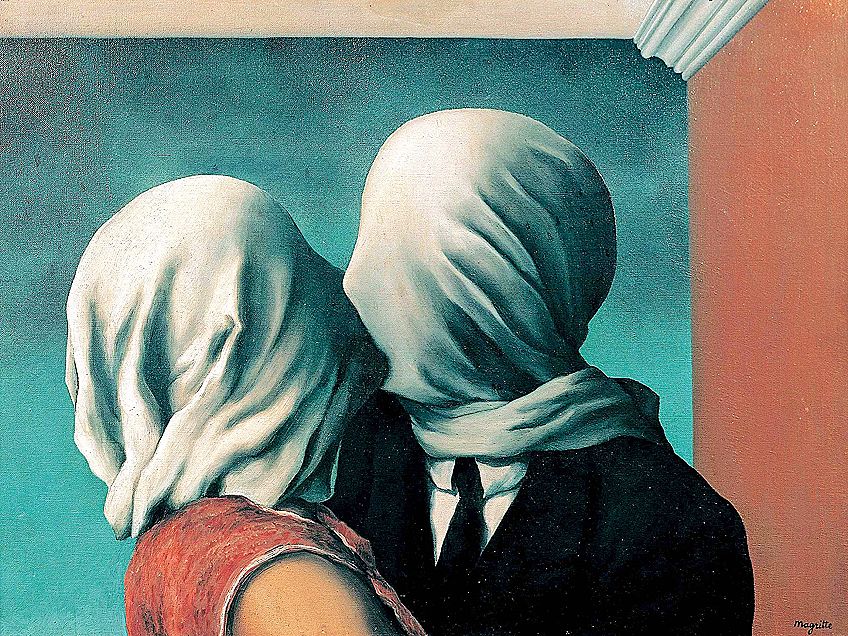
Composition
Both The Lovers and The Lovers II feature a composition that places the two figures in close proximity, engaged in an intimate embrace. Magritte positions the figures centrally, creating a sense of balance and symmetry. The composition draws the viewer’s attention to the primary subjects while isolating them from any specific context or background.
This isolation emphasizes the emotional connection between the lovers and invites interpretation beyond the confines of physical space.
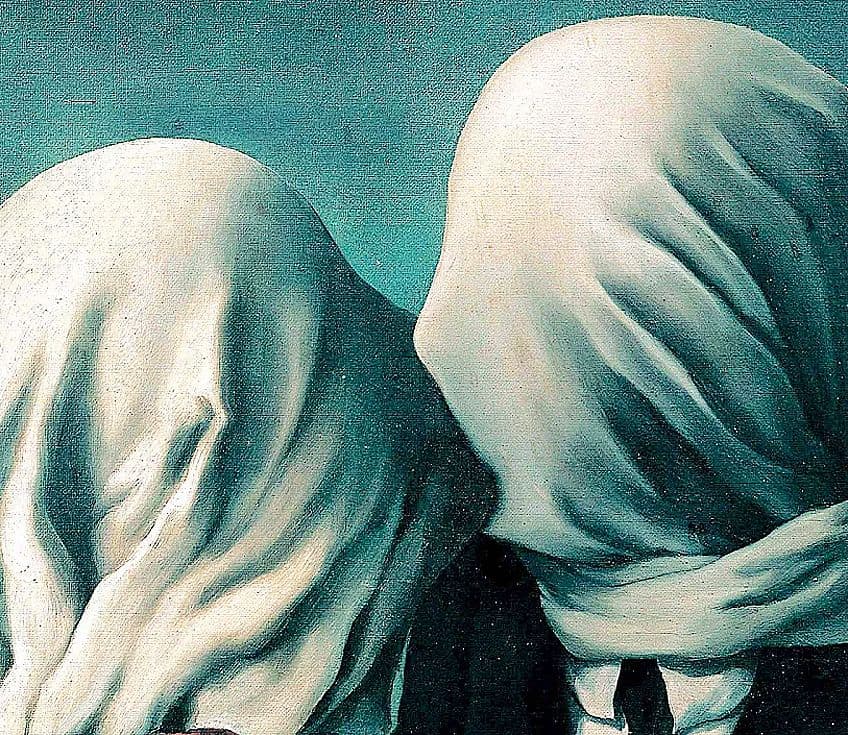
Color Use
Magritte employs a muted and subdued color palette in both paintings, utilizing earthy tones, grays, and blues. This deliberate choice creates a dreamlike atmosphere, enhancing the sense of mystery and abstraction. The limited color range adds to the timeless quality of the works, allowing the focus to remain on the figures and their interaction, rather than the surrounding environment.
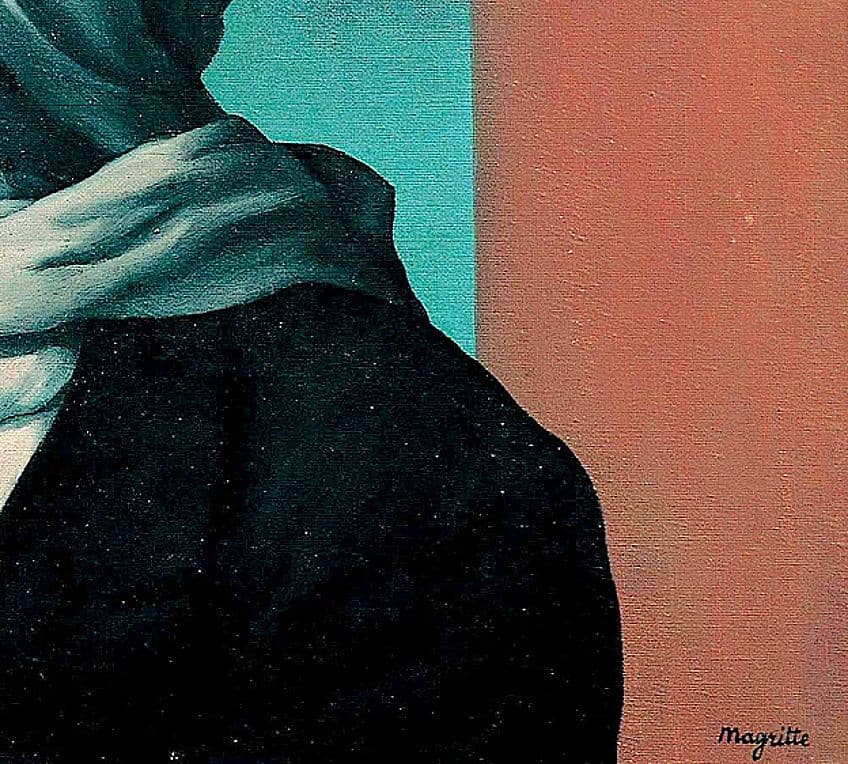
Texture
Magritte’s paintings exhibit a smooth and precise application of paint, emphasizing meticulous attention to detail. The figures and their surroundings appear almost flawlessly rendered, contributing to the sense of illusion and hyperrealism.
The absence of visible brushwork adds to the ethereal quality of the scenes, blurring the line between the tangible and the imagined.
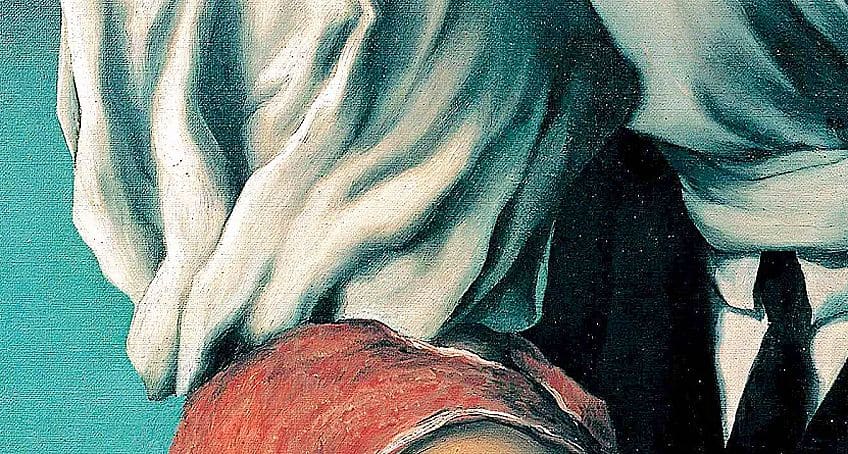
Perspective
Both paintings showcase a flat and frontal perspective, denying the viewer traditional depth and spatial cues. The figures are presented as if suspended in a void, challenging notions of perspective and physical reality. This deliberate distortion enhances the dreamlike quality of the scenes, forcing the viewer to question the boundaries of perception and the nature of the depicted relationship.

Style
Magritte’s unique style, characterized by a meticulous representation of objects and figures combined with unexpected and juxtaposed elements, is evident in both paintings. The precise rendering of the figures and the attention to detail exhibit a hyperrealistic approach.
Simultaneously, the inclusion of unconventional elements, such as the veiled faces or the fragmented forms, introduces an element of disruption and provocation.
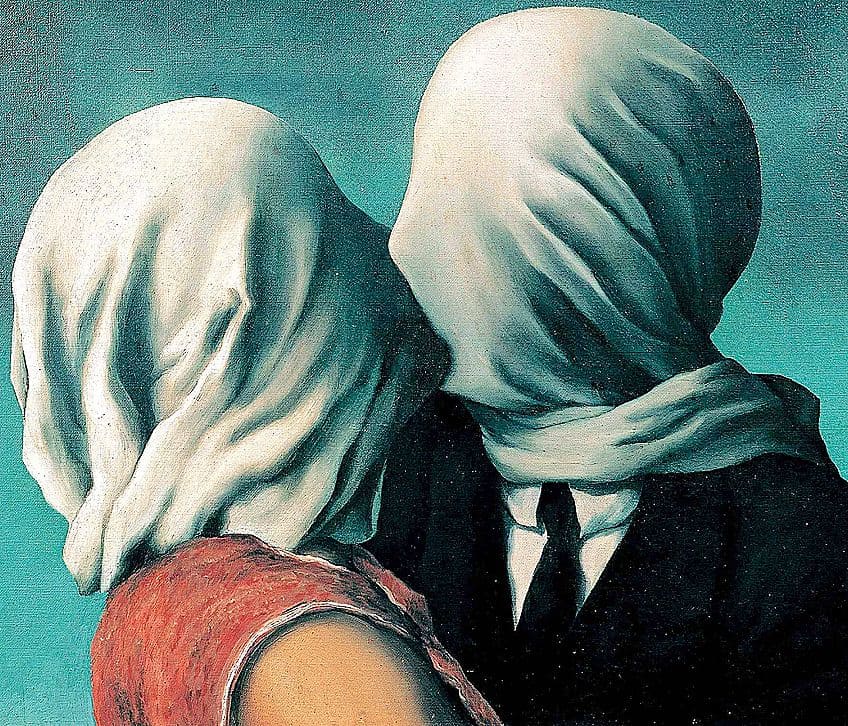
Symbolism
Symbolism plays a central role in both The Lovers painting and The Lovers II painting. Magritte employs various symbolic elements to evoke deeper meaning and invite interpretation. The veiled faces of the lovers represent the concealment of identity, highlighting the universal nature of love beyond individual characteristics. The juxtaposition of the figures’ physical union and the barriers that separate them suggests the complexities and paradoxes inherent in human relationships.

In conclusion, Les Amants by René Magritte stands as a testament to the artist’s ability to provoke contemplation and intrigue through his enigmatic works. Through its composition, color use, texture, perspective, style, and symbolism, Les Amants exemplifies Magritte’s mastery of surrealism and his exploration of the complexities of human relationships. The paintings challenge traditional notions of love, identity, and reality, inviting viewers to unravel its symbolic depths. With its haunting imagery and thought-provoking juxtapositions, Les Amants continues to captivate audiences, leaving an indelible mark in the art world and inviting us to ponder the mysteries that lie within the depths of our own hearts and minds.
Frequently Asked Questions
What Makes the Series Les Amants by René Magritte So Striking?
René Magritte’s The Lovers painting and The Lovers II captivate viewers with their thought-provoking composition, color use, texture, perspective, style, and symbolism. Through the meticulous rendering of figures and objects, combined with unexpected and surreal elements, Magritte challenged the boundaries of reality, inviting audiences to delve into the depths of the human psyche. While both paintings share similarities in their visual and conceptual approach, they also offer distinct nuances, further enriching the enigmatic allure of Magritte’s oeuvre. The lasting impact of these artworks lies in their ability to evoke emotions, question perceptions, and leave viewers contemplating the profound mysteries of love.
How Was Les Amants by René Magritte First Received?
When Les Amants (The Lovers) by René Magritte was first unveiled, it sparked a range of reactions and interpretations among viewers and critics alike. The painting, with its provocative imagery and enigmatic symbolism, challenged traditional notions of art and pushed the boundaries of surrealism. Some viewers were captivated by the haunting and thought-provoking composition, praising Magritte’s ability to evoke emotions and engage the viewer’s imagination. Others found the painting perplexing and elusive, and struggled to decipher its hidden meanings.
Nicolene Burger, a South African multimedia artist and creative consultant, specializes in oil painting and performance art. She earned her BA in Visual Arts from Stellenbosch University in 2017. Nicolene’s artistic journey includes exhibitions in South Korea, participation in the 2019 ICA Live Art Workshop, and solo exhibitions. She is currently pursuing a practice-based master’s degree in theater and performance. Nicolene focuses on fostering sustainable creative practices and offers coaching sessions for fellow artists, emphasizing the profound communicative power of art for healing and connection. Nicolene writes blog posts on art history for artfilemagazine with a focus on famous artists and contemporary art.
Learn more about Nicolene Burger and about us.
Cite this Article
Nicolene, Burger, ““Les Amants” by René Magritte – The Lovers Painting Analysis.” artfilemagazine – Your Online Art Source. June 12, 2023. URL: https://artfilemagazine.com/les-amants-by-rene-magritte/
Burger, N. (2023, 12 June). “Les Amants” by René Magritte – The Lovers Painting Analysis. artfilemagazine – Your Online Art Source. https://artfilemagazine.com/les-amants-by-rene-magritte/
Burger, Nicolene. ““Les Amants” by René Magritte – The Lovers Painting Analysis.” artfilemagazine – Your Online Art Source, June 12, 2023. https://artfilemagazine.com/les-amants-by-rene-magritte/.


